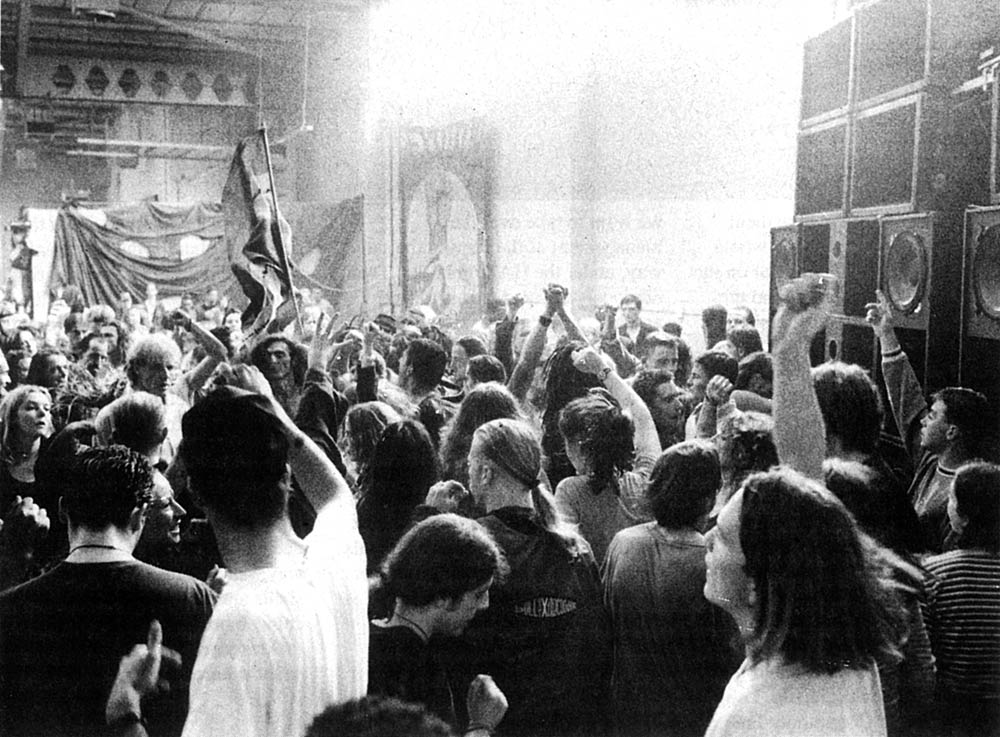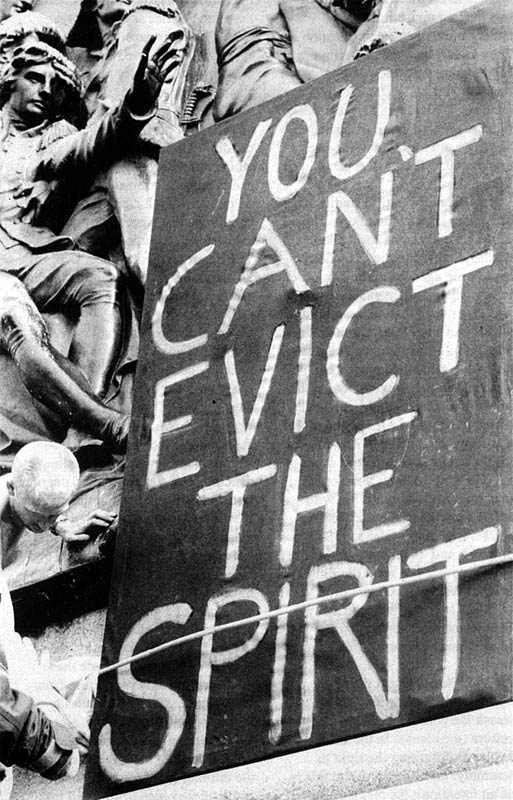
Introducing Exodus - Six-part Special - Pt. 6
Who Spiked The Dance Floor?
Exodus - The Dances
Squall 8, Autumn 1994, pp. 50-52.
When the British public reads about another dancer dying on the dance floor, the whole rave scene is summoned back to the dock to be judged by the media. It could be validly argued that rave culture is rarely out of the dock but the recent death of 20 year old Andrew Stoddart at the Hanger 13 Club in Ayr, Scotland, sparked off a renewed volly of cross-examination. The questions asked, however, proved irrelevant, the answers distracted and the verdict contradictory to reality.
Once again the politicians and media sociologists pronounced drugs to be the explanation for all ills, so closing the file marked 'lessons to be learned', before anyone really had a chance to study the facts of the case. And of course the facts of the case have far more to say than the easy explanations offered in the public arena so far.
Following another licensed rave in Grangetown, Cardiff this August, the national press reported that "the police have issued a fresh warning over the illegal drug Ecstasy", after a raver had collapsed into a coma. In September, another fatality in a club at Saltcoat in Ayrshire pushed the number of rave deaths in Strathclyde to a staggering 60 this year.
"I've got me reservations about E's cause it ain't all MDMA, but if people died by taking E's then you'd have thousands of people dropping dead - corpses everywhere" says Glenn Jenkins from the dance (and more) posse, the Exodus Collective.
Fact one in the reopened file is the drug itself, still called Ecstasy, but with a contents that has radically altered over the last 6 years as a direct consequence of government attempts to come down hard on it when it first appeared in Britain.
"In 88 when the rave scene was busting up from the underground, they came down on it. They knew about the gatherings and the MDMA and they knew how to get to it and fuck it up," explains Bigs, a dread member of Exodus. "They clamped right down on it and it disappeared. There wasn't no MDMA for 15-18 months. Then MDA came back in abundance."
Recent scientific studies have backed up such observations. Gay Times recently sent 17 so called 'ecstasy' tablets to the Manchester based drug agency Lifeline, in order to have their content examined. It was discovered that only one of the tablets had any MDMA in it and even this was only a a trace amount. The rest of the tablets contained mostly MDA, which has a neurotoxicity twice that of MDMA and is cheaper to knock out than 'real' Ecstasy because it is the parent drug from which MDMA is refined. One of the tablets was found to contain 177mg of MDA, over twice the active dose.
"With MDMA you don't get no muggings and stabbings but with MDA sometimes you do. With MDMA, even if you're a racist, you drop one and it fucks it right off out the window if you meet the right people. With MDMA you drop your defences and it helps community. They knew that, that's why they come down heavy on it," observes dread Bigs.
Whether or not the government's intention was to smash the collective power of rave culture (the clauses in the Criminal Justice Bill limiting the right to assembly, do further indicate this to be an intention), the result of the government clamp down on MDMA has lead to the increased prevalence of the more physiologically harmful MDA. The main reason for this, is that MDMA, being a time consuming distillation of MDA, is far more expensive to produce. Once the government had clamped down on MDMA, the drug was effectively handed over to black-market profiteers who knew they could make far more for far less, by using MDA. Put simply, the clamp down instigated by the government, served to stamp Ecstasy's future with the corrupting power of purely commercial motivation.
Earlier this year, the government's Advisory Council on the Misuse of Drugs sent a report to the Home Office saying that raves should in fact be encouraged and licences easier to obtain. The reports' reasoning was that by keeping raves financially exclusive and by forcing the drugs' distribution into the hands of the solely profit motivated, the conditions were created in which people are ingesting chemicals, the content of which they do not know, and then dancing in conditions that were inviting serious and life threatening physiological trauma. The report entitled 'Police, Drug Misusers and the Community' is still awaiting publication by the Home Office but with clauses in the Criminal Justice and Public Order Bill which go directly against its recommendations, Michael Howard is not keen to have it see the light of day.
Fact two in the re-opened file book is the environment in which ravers are dancing. This too has altered over the last 6 years, not least in the manner in which licences are granted and the manner in which unlicensed raves have been the target of political and media hammer blows. Going into the nineties, the establishment view of raves were of a massively multiplying and officially uncontrollable cultural phenomenon. The media fuelled hysteria was not enough to persuade those who came across rave culture from ignoring the positive community experience of participating in a rave. Not only did millions of people discover this accessible form of dance music and the missing sense of community it instilled, they also discovered that the way most politicians and media described the phenomenon was in direct contradiction to their own experience. As a result, a crackdown came with the formation of Police rave units, briefed to bust the flourishing unlicensed rave scene. Consequentially, rave organisers were forced to consider trying to obtain official licenses costing considerable amounts of money. Such licensed raves were of course more acceptable to the government, as they provided a pull-the-plug control for local authorities, as well as siphoning back to the authorities some of the considerable amounts of generatable from a rave.
But in the same way as government clamp downs on Ecstasy served to hand the contents of the tablet over to the profiteers, so too did the clamp down on unlicensed festivals and raves push the scene in the commercial direction. The official insistence on obtaining licenses rendered the organisation of raves an exclusive activity for those that had the money. This put off those that didn't have any, and further attracted those that did and who wanted to make more. Again, similar to the unhealthy change in tablet content, came the unhealthy over-emphasis on the commercial development of rave culture and the corruption of the dance environment.
The death of Andrew Stoddart at the Hanger 13 club in Ayr, Scotland in August was the third fatality at that venue this year. Hangar 13 is a licensed venue and a review of recent rave deaths and collapses, show that by far the majority occur in licensed venues.
So what's the coup? Glenn Jenkins, a spokesperson for the Exodus Collective, is in no doubt.
"It's laughable what the Independent is saying about "If you close down these clubs (where the deaths have occurred) then you'll drive people to these 'dangerous unlicensed raves'. Well people don't die at our 'unlicensed raves', people don't even get hurt, and if they do we have first aid on site and loads of people around caring."
In fact witnesses present on the dance floor of Hanger 13 on the night Andrew Stoddart collapsed and died, say that when he was taken ill, the people around him advised him to "dance it off". Undoubtedly, all night dancing does put some stress on the stamina of the body (as well as helping to relieve it!), with dehydration being the most common ailment. On the packed dance floor of Hanger 13, well known for being a hard-core full on rave club, fresh air and water were not freely available to the dancers. Exodus on the other hand operate free raves at different venues in and around Luton and nearly all 54 of the dances they've organised have been unlicensed. In that time they have not had a single collapse or fatality. Present at all their dances is Anna in a first aid van with plans afoot to purchase their own ambulance and fire fighting vehicle. Glenn Jenkins is in no doubt what is killing the dancers.
"It's the conditions into which they're squeezed. Rather than allow them to happen unlicensed and giving people the right to gather, they try and drive them into this club situation and of course the commercial heads are exploiting it to the max. Where at these other parties you drop to the floor and start vomiting or something, then you're bad for business. It's out the door mate - out the door. And it's the commercial concern that makes these clubs turn off the water so you buy it from them at £3 a bottle."
Although illegal, turning off the water taps and upping the heating is not an uncommon occurrence in many commercial rave clubs. It is undoubtedly a major factor in the deaths of those that are packed onto oven temperature dance floors, perhaps having swallowed a pill of dubious content.
In sharp contrast to the Exodus dance experience, is the club Sanctuary in nearby Milton Keynes. Sanctuary charge £15 admission to their rave nights and according to local dancers, regularly turn off the cold water taps and pack the dance floors. In August of this year a dancer died on the dance floor at Sanctuary. It was small surprise to Exodus' Glenn Jenkins when another dancer died on the dance floor of the Hangar 13 club: "Have you seen the pictures of the dances there? - crammed tight. That's the real argument. What's killing the kids - profit or raves?"

It is of a seemingly relentless irony that the Government's continued attempts to stamp on any culture it finds economically unacceptable, simply turns out to increase crime and ill health, and yet is billed as being designed at achieve the opposite. The Criminal Justice and Public Order Bill with its criminal sanctions on unlicensed amplified music, takes, or rather poisons, the biscuit. It is also increasingly obvious that everything this form of government touches, ends up smelling of money and is consequently poisoned by the power of that smell to steal away any sense of community, other than a business one.
"We're the victims - the people going to the dances," says Exodus' Glenn Jenkins. "That's one of the reasons we started doing our raves. To get away from that drug dealing, 'water turned off' atmosphere. Money money money and pitbulls, because that's what's killing people."
The unconsidered facts are the missing element that render any remedy harmful. At its most ignorant, misdiagnosis is man slaughter; at its most intentional it is murder. All facts considered the government stands accused.
Related Articles
Exodus Special - In This Issue::
A Now New Testament
Introducing Exodus
Exodus - The Battles
Exodus - A Chronology
Exodus - The Housing Initiative
Exodus - The Dances
To see Squall's full coverage of Exodus click here
